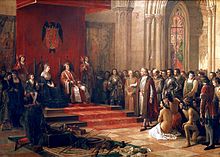Dynastic union

A dynastic union is a type of union in which different states are governed beneath the same dynasty, with their boundaries, their laws, and their interests remaining distinct from each other.[1]
It is a form of association looser than a personal union, when several states share the same monarch, and a real union, when they have common institutions in addition to the same monarch.
Historical examples
With the assassination of
Aragon and Barcelona
Marriage of Count of Barcelona
Castile and Aragon
Marriage of Isabella I of Castile and Ferdinand II of Aragon in 1469 that laid the foundations for the kingdom of Spain. They did not ascend to their respective thrones until 1474 and 1479 respectively.[4]
Spain and Portugal (Iberian Union)
Dynastic union between Spain (the union between the Crowns of Castile and Aragon) and
Lithuania and Poland
Marriage of
Following Salic law, Henry III, King of Navarre, a member of the House of Bourbon, succeeded to the French throne in 1589 upon the extinction of the male line of the House of Valois. Both houses were cadet branches of the Capetian dynasty, the ruling house of the kingdom of France since 987.
Scotland and France
Norman or French culture first gained a foothold in Scotland during the
The prospect of dynastic union came in the 15th and 16th centuries, when
Cordial economic and cultural relations did continue however, although throughout the 17th century, the Scottish establishment became increasingly
England and Scotland
When
United Kingdom and Hanover
The personal union between the United Kingdom of Great Britain and Ireland and the Kingdom of Hanover, jointly ruled by the head of the House of Hanover since 1707, ended with the death of William IV in 1837, and was replaced with a dynastic union: due to the different laws of succession, he was succeeded by two members of the dynasty, in the United Kingdom by his niece Victoria, the daughter of his late next brother Prince Edward, Duke of Kent and Strathearn, and in Hanover by his second next brother Ernest Augustus. This lasted until the annexation of Hanover by Prussia in 1866.
References
- ^ Lalor, ed. Various authors. See Contents. Cyclopaedia of Political Science. New York: Maynard, Merrill, and Co., ed. John Joseph Lalor, 1899.
- ^ John C. Shideler. "A Medieval Catalan Noble Family: the Montcadas, 1000–1230". Retrieved 24 April 2008.
- ISBN 84-96019-28-4. 127pp.
- ^ H. J. Chaytor. "Juan II. Union of Aragon with Castile". A History of Aragon and Catalonia. Retrieved 17 April 2008.
- ^ Stanley G. Payne. "Chapter Ten, The Expansion". A History of Spain and Portugal, Volume 1. Retrieved 24 April 2008.
